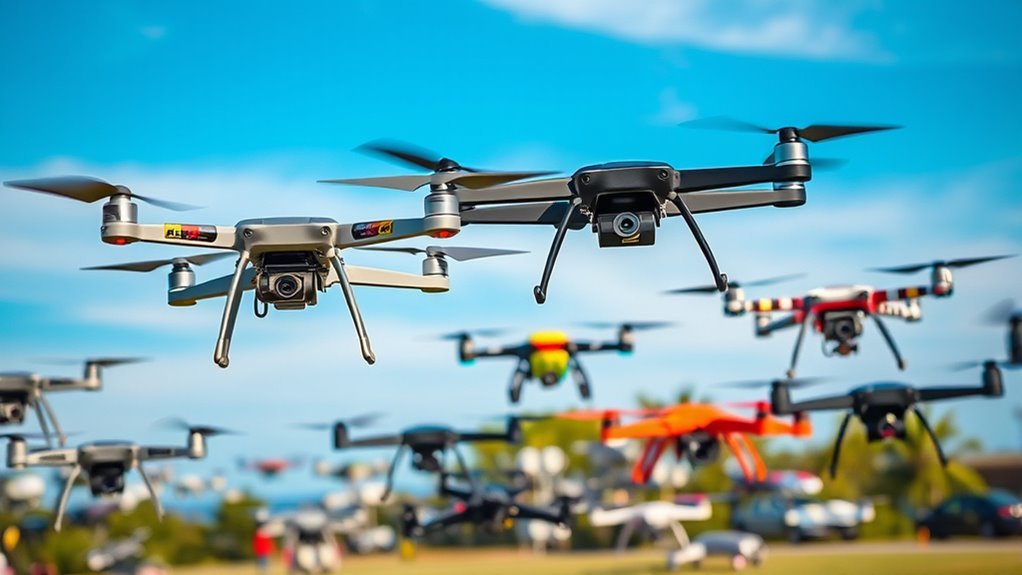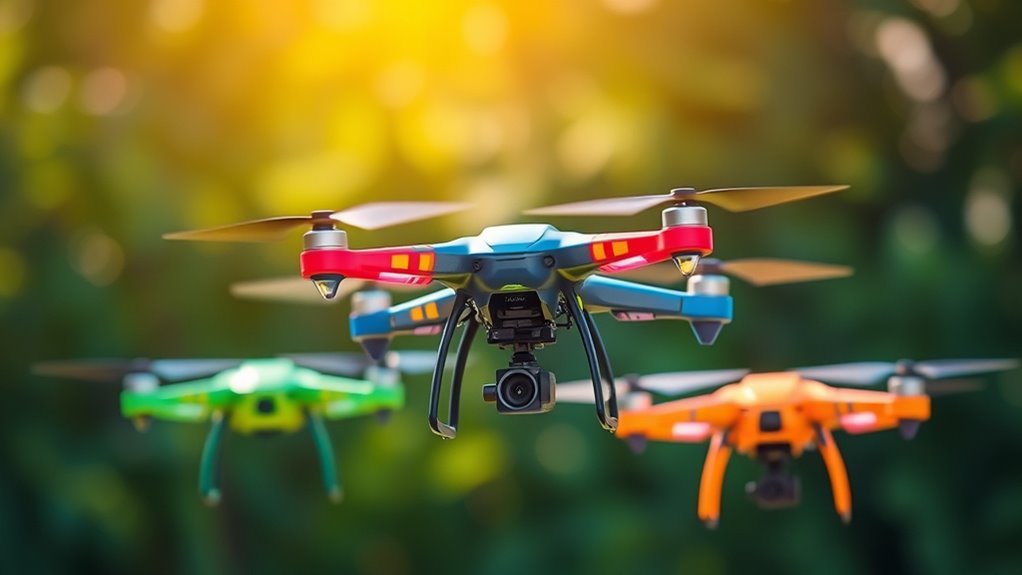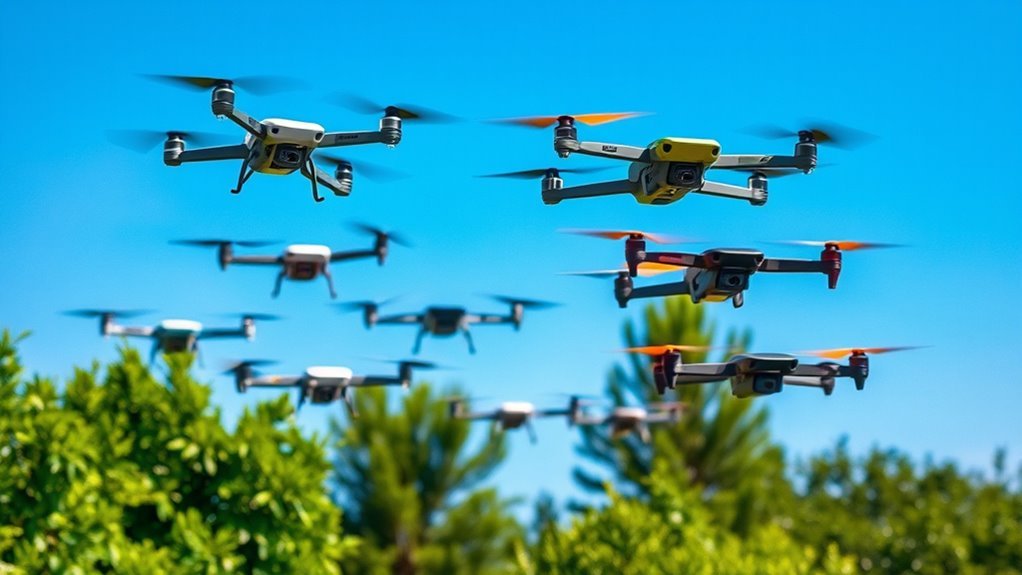Different drones produce unique sounds based on their design and function. Quadcopters typically hum between 300 Hz and 1 kHz, while racing drones exhibit a high-pitched roar from their high RPMs. Fixed-wing drones whisper due to aerodynamic efficiency, and hexacopters buzz with stability from six rotors. Agricultural drones generate a low, powerful hum, whereas surveillance drones emit distinct whirs, potentially compromising discretion. Delivery drones vary in noise levels, with quieter models designed to minimize urban intrusion. Continue to explore the various sound profiles of these drones.
The Hum of Quadcopters

While you might appreciate the versatility of quadcopters, their distinctive hum is one of the most notable aspects of their operation. This sound primarily arises from the quadcopter frequency, which typically ranges between 300 Hz and 1 kHz. The pitch and volume can vary based on the rotor speed and design. Understanding sound perception is essential, as the hum can evoke different emotional responses and even influence flight experiences. For enthusiasts, this auditory signature symbolizes freedom and exploration, enhancing the connection to the aerial environment. Additionally, the hum serves practical purposes; it allows nearby individuals to recognize the quadcopter’s presence, promoting safety during flight. Ultimately, the hum is an integral part of the quadcopter experience.
The Roar of Racing Drones

Racing drones produce a distinct engine sound characterized by high RPMs, which creates a roaring effect that enhances their aggressive performance profile. The dynamics of their propeller whirl greatly impact aerodynamics and noise levels, producing a sharp, cutting sound that distinguishes them from standard quadcopters. Understanding these acoustic characteristics is essential for evaluating their efficiency and competitive edge in racing scenarios.
Racing Drone Engine Sounds
As you immerse yourself in the world of drone racing, you’ll quickly notice that the sound of these high-performance machines is as exhilarating as the competition itself. The roar of racing drones, driven by powerful brushless motors, is a symphony of precision and speed. Each drone’s engine emits a unique pitch, reflecting its race drone specifications.
| Engine Type | Sound Characteristics |
|---|---|
| Brushless | High-pitched whine |
| Brushed | Deeper, throaty growl |
| 4S Battery | Loud and aggressive |
| 6S Battery | High frequency whirr |
These sound profiles not only enhance the thrill during racing drone competitions but also signify the technological advancements that define competitive racing today.
Propeller Whirl Dynamics
The sound of propellers in racing drones plays a pivotal role in the overall auditory experience, contributing greatly to the machines’ performance and presence. As you analyze propeller efficiency, you’ll notice that sound frequency varies considerably with rotor design and speed. High-pitched whirs indicate rapid rotation, enhancing the perception of speed and agility. Conversely, lower frequencies often signify a more stable, steady flight path, essential for precise maneuvers. The interaction between the propeller blades and air generates distinct frequencies that can inform you about the drone’s operational state. Understanding these dynamics not only enhances your appreciation for the technology but also offers insights into optimizing performance, allowing you to harness the thrilling freedom of racing drones while enjoying their enthralling sound profiles.
The Whisper of Fixed-Wing Drones

When you consider fixed-wing drones, their aerodynamic design plays an essential role in minimizing noise levels. Unlike racing drones that produce significant sound due to their rapid movements, fixed-wing models can operate more quietly, thanks to their sleek profiles and efficient propulsion systems. This design not only enhances flight efficiency but also creates a less intrusive sound signature in various environments.
Aerodynamic Design Impact
While fixed-wing drones are often celebrated for their efficiency and range, their aerodynamic design plays an important role in minimizing noise output. By optimizing wing shape and body contours, these drones enhance aerodynamic efficiency, reducing drag and allowing for quieter operation. The streamlined design allows air to flow smoothly over the surfaces, decreasing turbulence, which is a primary contributor to sound frequency. Unlike multi-rotor drones that generate more chaotic airflow, fixed-wing models maintain a more uniform sound profile, resulting in a lower perceived noise level. This design not only improves flight duration but also provides a quieter experience, making fixed-wing drones particularly appealing for applications where discretion and environmental impact are crucial. Consequently, the aerodynamic design greatly influences their acoustic performance.
Noise Levels Comparison
Although many factors contribute to the overall noise levels of drones, fixed-wing models consistently demonstrate a distinct advantage due to their design and operational characteristics. With efficient aerodynamics, these drones minimize turbulence, resulting in lower sound emissions. The propulsion systems used in fixed-wing drone technology often operate at quieter frequencies compared to their multi-rotor counterparts. This reduced noise output considerably alters sound perception, making them less intrusive in sensitive environments. As a result, you can utilize fixed-wing drones for applications requiring discretion, such as wildlife monitoring or surveillance. Understanding these nuances can help you choose the right drone for your needs, allowing you the freedom to operate in less disruptive ways while maintaining operational effectiveness.
The Buzz of Hexacopters
Hexacopters, known for their six rotors, produce a distinctive buzz that sets them apart from other drone types. This sound is not just noise; it reflects their unique hexacopter features and versatile hexacopter applications. When you hear a hexacopter, you’re recognizing:
- The increased stability from six rotors
- Enhanced payload capacity, allowing for various equipment
- Superior maneuverability in diverse environments
- Longer flight times due to optimal power distribution
- Applications in aerial photography, surveying, and search and rescue
This buzz signifies reliability and performance, making hexacopters a favored choice for both recreational and professional users. Understanding this sound can enhance your appreciation for the technology and its capabilities, ultimately granting you the freedom to explore new possibilities in the drone landscape.
The Thrum of Octocopters
When you hear the rhythmic thrum of an octocopter, it immediately signals superior stability and power. This distinct sound arises from its octocopter design, which utilizes eight rotors to deliver enhanced lift and maneuverability. The aerodynamic efficiency of these rotors allows for a smooth flight experience, making octocopters ideal for various applications, such as aerial photography, surveying, and search-and-rescue missions. Unlike other drone configurations, the octocopter’s balanced thrust minimizes vibrations, resulting in clearer imaging and more precise operation. As you observe this marvel of engineering in action, you appreciate how its sound encapsulates the freedom and versatility that modern drone technology offers, empowering users to explore and capture the world from new heights. Additionally, the advanced stabilization technology of octocopters ensures stable hover and smooth shifts even in moderate wind. The robust construction of octocopters contributes to their durability, enabling them to withstand varied environmental conditions during operations.
The Chop of Toy Drones
While octocopters offer a robust flying experience, toy drones present a different auditory signature characterized by a sharp, staccato chop. This sound frequency is a product of their simplified design and lightweight toy drone features, which contribute to a distinctive acoustic profile.
You might notice that:
- The chop is more pronounced at lower altitudes.
- Blade size affects the intensity of the sound.
- Propeller speed plays an essential role in sound variation.
- Material composition influences the pitch and quality.
- Battery life can impact motor efficiency, altering sound.
- The durable materials used in toy drones help reduce noise levels during flight.
- The use of advanced battery optimization techniques in some toy drones can also enhance performance, allowing for quieter operation during flight.
Understanding these factors allows you to appreciate how toy drones create their unique auditory landscape, enhancing your flying experience and sense of freedom in the skies.
The Sound of Agricultural Drones
How does the sound of agricultural drones differ from that of smaller consumer models? Agricultural drones are typically larger and equipped with more powerful motors, producing a deeper, more resonant hum. This sound reflects their design for precision agriculture, where efficiency is essential. Their noise level can be higher, but many find it less intrusive compared to smaller drones.
| Drone Type | Sound Characteristics |
|---|---|
| Agricultural Drones | Low hum, powerful, efficient |
| Consumer Drones | High-pitched, less powerful |
| Noise Level | Higher but less intrusive |
| Purpose | Crop monitoring, spraying |
Understanding these sound differences can enhance your appreciation for their role in advancing drone efficiency in agriculture.
The Noise of Surveillance Drones
Although surveillance drones vary in design and size, their noise characteristics are generally marked by a distinct whirring sound that can often be more intrusive than that of agricultural models. This noise is a significant aspect of drone acoustics and raises concerns about privacy and freedom.
Key considerations include:
- Detection: Their sound can betray their presence, impacting covert operations.
- Public Awareness: The whirring can heighten awareness of surveillance technology in populated areas.
- Psychological Impact: The noise may induce feelings of unease among citizens.
- Regulatory Challenges: Noise levels could influence legislation regarding drone operations.
- Technological Development: Advances in design aim to reduce acoustic footprints for better compliance with privacy norms.
Understanding these factors is essential for addressing the implications of surveillance drones.
The Acoustic Signature of Delivery Drones
As delivery drones increasingly become part of urban logistics, their acoustic signature plays an essential role in shaping public perception and acceptance. The soundscapes generated by these drones can vary considerably based on design, motor type, and payload. Lower noise emissions are often a priority, aligning with delivery drone regulations aimed at minimizing disruption. You’ll notice that quieter models utilize advanced propulsion systems, resulting in a less intrusive auditory experience. Conversely, louder drones might evoke concerns about noise pollution, impacting community acceptance. Understanding these acoustic characteristics is critical for developers and regulators alike, as they work to balance technological advancement with public comfort. Ultimately, a favorable acoustic signature could facilitate greater integration of delivery drones into everyday life.
Frequently Asked Questions
How Do Drone Sounds Differ in Various Environments?
You’ll notice drone sounds vary markedly between urban and rural environments. In cities, noise reflects off buildings, creating echoes. In contrast, rural areas allow clearer, more direct sounds, influenced by open spaces and natural surroundings.
Can Drone Sounds Affect Wildlife Behavior?
Yes, drone sounds can greatly impact wildlife behavior. Increased noise levels often lead to wildlife stress, causing altered feeding and mating habits. Understanding this drone impact is essential for minimizing disturbances in natural habitats and preserving biodiversity.
What Materials Influence Drone Noise Levels?
The materials you choose for propeller construction and frame design greatly influence drone noise levels. Lightweight, flexible propellers can reduce sound, while rigid frames might amplify vibrations, creating a more pronounced acoustic signature during flight.
Are There Regulations on Drone Noise Pollution?
Yes, there’re drone regulations addressing noise pollution. Many regions enforce noise standards to minimize disturbances. By understanding these regulations, you can guarantee compliance while enjoying the freedom drones offer without infringing on others’ peace.
How Can I Reduce My Drone’s Noise Output?
Isn’t it frustrating when noise disrupts your freedom? To reduce your drone’s noise output, focus on optimizing drone design and implementing noise reduction techniques like propeller modifications and vibration dampening to enhance your flying experience.

